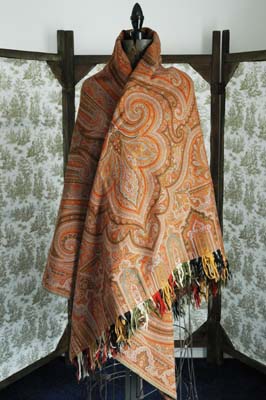|
Auction Tips
Caring for Antique and Vintage Textiles
 You attended an auction and came back with a suitcase full of antique linen baby dresses, silk ladies' hats, gloves and gowns. Everything is dusty and smelly and you have no idea where to start making it presentable?
You attended an auction and came back with a suitcase full of antique linen baby dresses, silk ladies' hats, gloves and gowns. Everything is dusty and smelly and you have no idea where to start making it presentable?
Here are a few hints and tips to help you along the way to caring for these items so that they may be shown to their best advantage and eventually passed on to the next generation of collectors:
Start by laying an old tablecloth or a sheet (ideally white) on a large flat surface. If you feel the items are quite valuable, do not hesitate to wear white cotton gloves to manipulate them. The dust and oil on our hands, no matter how clean they may be, can be transferred to fabrics and eventually cause stains or compromise the durability of the material. Lay everything down under a good light but not in bright sunshine � too much direct sun can damage fragile materials, especially older ones.
Look at the inside of the suitcase or the bags in which you carried the items in case there is a darkish powder residue � this may indicate the presence of moths or other insects, some of which feed on the protein fibres (wool, linen, cotton, etc.), others which feed on the glues and cardboards. If you suspect some infestation, you can contact a local museum and ask for their recommendation, but a good method is to place the garments in a heavy storage plastic bag, remove the air with the nozzle of a vacuum cleaner and place the bag in the deep freezer for a few days in order to kill the insects.
Otherwise, start inspecting the items. Make sure you do not wear any jewellery, belt buckles, etc. that may snag at fragile materials, especially woollens. Remove any pens, markers, etc. from your work surface and do not smoke, eat or drink during the inspection.
Many items such as boots, hats, heavy coats, may be perfectly happy with a simple good brushing with a fine clothes brush, being careful to turn out pockets, cuffs, collars or any other areas (such as the inside of pleats) where dust and dirt may have accumulated.
Make sure you never hang antique garments as their weight will pull at the shoulder seams and may cause tears. They should rather be placed flat in a drawer (or ideally a linen press) between layers of acid-free paper and inside cloth bags. They should at least be placed away from direct sunlight; a cedar chest or cedar-lined dresser is excellent. Silks need special care because, especially in the Victorian period, it was often weighted to add body to it and make it stand stiffer. The mixture of iron and salt that was used can deteriorate the material with time. When storing silk items, a layer of acid-free paper should be placed between each layer of material so they do not touch, and care should be given to never use water near old silk, as it will automatically become stained beyond repair.
And as tempting as it may be, refrain from wearing antique or vintage garments � our body shapes rarely fit them and the strain on the seams may cause irreparable damage. Here again the heat and oils from the body may also hasten deterioration as would dust, pollution and other irritants.
Antique and vintage fabrics can give you years of enjoyment if you take these few precautions in order to preserve your investment. As our grandmothers would say, an ounce of prevention is worth a pound of cure.
Author: Johanne Durocher Norchet
Are you interested in collecting vintage clothing? Send us an e-mail and let us know. We'll try and keep and eye out for you. In the meantime, you can search for vintage clothing in all of our current auction items.
This article has been provided by Theresa Taylor Auctioneering to help our customers. Would you like to see an article on another subject? Drop us a line.
|

